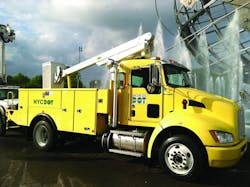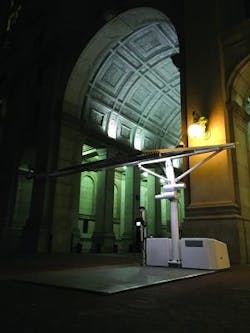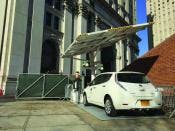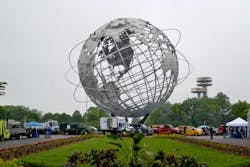From the city that never sleeps comes sustainability that never rests. New York City, long one of the nation’s leaders when it comes to fleet sustainability efforts, is pushing the envelope on its green fleet efforts further than ever before.
The New York City Fleet (NYC Fleet), though, is not one operation. It is not a collection of refuse trucks that adopt natural gas fueling. It is not just a municipal police force running hybrid technologies. And it is not only a heavy-duty truck fleet filling up on biodiesel. It is all of these … and so much more.
The fleet, much like the city’s well-known nickname, never sleeps on sustainability. For its efforts, Fleet Owner has named NYC Fleet its 2016 Green Fleet of the Year.
New York is running perhaps the widest variety of alternative power vehicles and technologies in the nation. From biodiesel, to hybrids, to electric, and even solar power, if a technology is available, there is a good chance the city’s diverse fleets have tested it.
“That’s probably not far from the truth,” says Keith Kerman, deputy commissioner and chief fleet officer for the city’s Dept. of Citywide Administrative Services (DCAS). DCAS is one of some 50-plus agencies in the city that utilize vehicles in their operations. The agency is dedicated to managing the entire city vehicle fleet—some 28,000 vehicles—and helping the other agencies find sustainable solutions. According to Kerman, about 2,000 people are employed in fleet services or dispatch roles in the city with an annual budget of nearly $800 million.
“One of the challenges of DCAS is that the resources are in one of the [individual] agencies,” Kerman notes. “It is our job to run a common program, a common sustainability program, and a common safety program.”
And because of that, when DCAS comes up with a recommendation for a fuel-saving technology, it must then get the agency or agencies on board. That job is made easier, Kerman says, due to the leadership of Mayor Bill de Blasio.
“We’ve gotten great leadership from Mayor de Blasio,” Kerman adds. “Having City Hall leadership be very clear about the direction we want to go [is] what empowers my agency to go to other agencies and say [this is what we want to do]. It’s what helps break down the silos.”
Electric push
Late last year, DCAS put out a call to take green fleet initiatives to new and unprecedented levels among municipal fleets. Spearheaded by de Blasio, the launch of NYC Clean Fleet (part of the mayor’s broader OneNYC plan) aims to cut vehicle emissions in half by 2025 and some 80% by 2035. Much of that will be through the expansion of the city’s electric vehicle fleet.
The city first introduced alternative-fuel vehicles and related technologies about 15 years ago, but this new initiative puts the city on the fast-track to sustainability. In addition to the expansion of the electric vehicle fleet, New York will increase the use of anti-idling, hybrid and stop-start technologies, among others, in its medium- and heavy-duty fleet. In all, Kerman estimates the city will spend about $3.5 billion in the next 10 years on equipment.
The main thrust of the plan, though, is the rapid expansion of electric vehicles from more than 300 currently to over 2,300 within 10 years’ time. No agency reflects that push more than the Parks & Recreation Dept. Paris Apollon, chief of operations for citywide services within Parks & Recreation, says the agency, which had zero electric vehicles three years ago, will have over 100 by the end of June and plans to replace every sedan in the agency with electric vehicles within nine years.
“It’s very ambitious,” he adds. “The expansion of the infrastructure is the key part of the plan.”
DCAS reports that, to no one’s surprise, plug-in electric and hybrid vehicles achieve greater fuel economy than full gasoline vehicles. According to DCAS, those numbers saw plug-in hybrids achieve 140% better fuel economy than a gas light-duty number. Hybrid vehicles saw 79% better fuel economy. Diesel pickups and vans were 27% more efficient than gas models.
According to the Fiscal Year 2015 actual fuel economy report, the city’s light-duty fleet achieved an average of 23.5 mpg in 2015 while the medium-duty fleet achieved 11.7 mpg. Medium-duty vehicles using biodiesel or diesel achieved an average of 14.4 mpg while gas-only medium-duty vehicles achieved just 11.3 mpg. The report notes that any vehicles averaging less than 5 mpg and over 60 mpg were excluded as outliers.
It’s these kinds of numbers that continue to push the city toward more sustainable transportation solutions. Part of that effort is on full public display each spring at the Parks & Recreation Dept.’s Vehicle & Equipment Show. The show, first run in 1988, annually attracts over a hundred vendors pitching their wares not just to the city’s fleets but also to outside fleets.
“More than 100 vendors coming to this show means they see value in the program,” Apollon says. “The participants really benefit because it’s a chance to bring everybody together to see the technologies—and maybe even test-drive the vehicles.”
Within the city fleet as a whole, the variety of technologies is impressive. Kerman says the city owns more than 6,000 hybrid vehicles, 200 natural gas vehicles, 3 natural gas refueling stations, more than 900 electric vehicles (both on- and off-road), and 138 solar vehicles (including signboards, carts and light towers). And that is just the small list of technologies in use.
All of the city’s heavy trucks operate on biodiesel. NYC Clean Fleet aims to further increase the use of alternative fuels including higher biodiesel blends, compressed natural gas, or renewable diesel to displace the use of traditional diesel fuel in city vehicles by 2035. The city estimates that these alternatives will reduce emissions 34%.
Variety to test
The size of the fleet itself is essential to the city’s vehicle sustainability plans. While a typical trucking fleet may test a variety of technologies at any given time, it has time and money constraints. And while a municipality also has financial constraints, the ability to have any one of 50 agencies, each with its own budget, testing a technology increases the ability to find the appropriate fits.
“We don’t buy vehicles to say we have electric vehicles ... We buy vehicles to provide services,” Kerman says.
An example of that is the rightsizing of vehicles. “Everyone wants SUVs. They’re bigger and they’re more comfortable,” Kerman points out. “But we want to run SUVs where they are [operationally suited].”
In fact, in the Fiscal Year 2015 report, DCAS noted that light-duty vehicles such as sedans and SUVs were over 100% more fuel-efficient than medium-duty vehicles such as pickups and vans. The Dept. of Environmental Protection (DEP) recently completed a rightsizing project. The agency switched about 20 vehicles from larger and more expensive Ford F-350 pickups to F-150 models because the need for the F-350 wasn’t there.
The city has also implemented a Zipcar-type arrangement called Fast Fleet to help city employees get around without purchasing additional vehicles. “We adopted Zipcar technologies so city cars can be shared cars,” Kerman says. “We’ve always had a problem with pooling [cars], but with Fast Fleet people use a card to reserve a car. It’s been a tremendous success, but a big culture change.”
“More than 100 vendors coming to this show means they see value in the program. The participants really benefit because it’s a chance to bring everybody together to see the technologies—and maybe even test-drive the vehicles.”
- Paris Apollon, chief of operations for citywide services within Parks & Recreation
DCAS’s ability to coordinate activities among the city’s diverse fleets also led to other fleets adopting technologies. The Parks Dept. biodiesel program is one example. Another is the New York City Fire Dept.’s efforts to reduce idling.
“One agency can be a testing lab for a certain type of technology,” Kerman points out. “For example, right now the Fire Dept. is testing Stealth Technologies’ anti-idling solution with the city ambulances, which run constantly. We think they will be able to achieve a 40% to 45% reduction in wear and tear and fuel use. Part of the NYC Clean Fleet [objective] is to bring those technologies to other fleets.”
The Dept. of Sanitation is another agency whose success with a technology has filtered over into other fleets. Sanitation, which has its own alternative fuel testing laboratory, did some innovative work with hybrid trucks, Kerman says. Also, the Parks Dept. worked with fuel-saving technologies on its bucket trucks, which other agencies employ.
“There is a crossover capacity,” Kerman says. “An agency will have a core competency, [i.e., the Parks Dept. and its bucket trucks for maintenance], but there is an opportunity to bring those safety and technology solutions to other agencies.”
Kerman says that since its introduction, the NYC Clean Fleet plan has already had significant success. The city has ordered 150 electric vehicles and is in the process of establishing citywide requirements for electric charging station contracts. There are currently about 250 stations throughout the city with plans to add 150 more; however, each agency has been responsible for implementing its own contracts, leading to variations.
There is also growing interest in renewable diesel to fuel vehicles. In December, the city put out a Request for Information looking for private industry ideas to increase technologies within its clean fleet. The request was met with plenty of enthusiasm among the private sector. Seventy-seven responses came in, Kerman says, to go along with about 20 other vendors the city was already engaged in discussions with about potential projects.
“We think this is a tremendous response with nearly 100 companies and nonprofits engaging in this process already,” he says. “We want to be in the forefront of all private fleets and fleets in general.”
In a city as large as New York, it’s important to get everybody on the same page when it comes to sustainability efforts. Apollon says one of the keys to that success has been the weekly Fleet Federation meetings.
“DCAS has spearheaded an effort where all agency heads meet every week,” he says. “This has been a very positive initiative because we can listen to others and hear their challenges and successes.”
“We have a lot of [need] to work together not just at the agency level, but also at the day-to-day level,” Kerman adds. “And that [meeting] is breaking down barriers to working together.”
As an example, Kerman notes how the Parks Dept. was among the first to use biodiesel in its heavy fleet vehicles. In fact, he says, only two agencies used biodiesel two years ago. Now, every city diesel vehicle runs on biodiesel rather than diesel.
Apollon says that with as many as 50 different types of vehicles—from golf carts to Class 8 crane trucks—the Parks Dept. has long been a great breeding ground for all sorts of new technologies.
“As technology changes, we try to adapt,” he says, “and as we look at technologies, some work and some don’t.”
Biodiesel has been one that does work. The fleet typically runs B20 in most of its vehicles but has tested blends up to B100, and Apollon says another test of B100 is likely on the horizon. In the meantime, it continues to tinker with the blend mix. The fleet is considering a switch to B40 or maybe even B50 for this summer.
The Parks & Recreation Dept. is also heavily involved in green building technologies, including solar power for generators and light towers.
Still, regardless of the agency, change is difficult to accept. For many fleets, the opportunity to be green presents itself in fuel savings. For New York City, that is true, but there is another side of the equation that Kerman says is equally important.
“We want New York City to be the most sustainable city in the world, and we want it to be a leader. On the other hand, what are the cost implications of children’s cancer?” he asks. “None of these things are mutually exclusive. If investing in the largest clean fleet in the country improves our image, improves residents’ health, and [still] saves money, that’s great.
“New York City is proud to be a leader in sustainability, but I think we’ve only just begun,” Kerman concludes.



